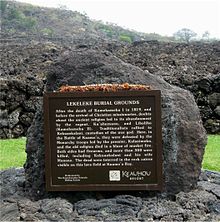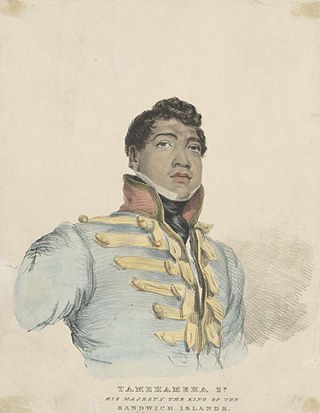
Kamehameha II was the second king of the Kingdom of Hawaii from 1819 to 1824. His birth name was Liholiho and full name was Kalaninui kua Liholiho i ke kapu ʻIolani. It was lengthened to Kalani Kaleiʻaimoku o Kaiwikapu o Laʻamea i Kauikawekiu Ahilapalapa Kealiʻi Kauinamoku o Kahekili Kalaninui i Mamao ʻIolani i Ka Liholiho when he took the throne.

Ruth Ke‘elikōlani, or sometimes written as Luka Ke‘elikōlani, also known as Ruth Ke‘elikōlani Keanolani Kanāhoahoa or Ruth Keanolani Kanāhoahoa Ke‘elikōlani, was a member of the House of Kamehameha who served as Governor of the Island of Hawaiʻi and for a period, was the largest and wealthiest landowner in the Hawaiian Islands. Keʻelikōlani's genealogy is controversial. Her mother's identity has never been in question but her grandfather Pauli Kaōleiokū's relationship to Kamehameha I is heavily disputed. While her father has been legally identified as early as 1864, disputes to that lineage continued as late as 1919. As one of the primary heirs to the Kamehameha family, Ruth became landholder of much of what would become the Bernice Pauahi Bishop Estate, funding the Kamehameha Schools.
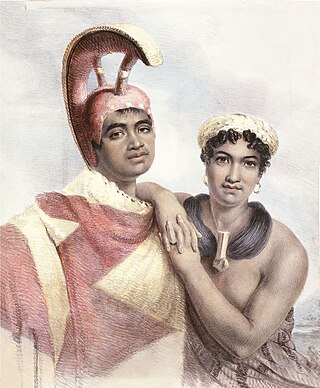
Kuini Liliha was a High Chiefess (aliʻi) and noblewoman who served the Kingdom of Hawaii as royal governor of Oʻahu island. She administered the island from 1829 to 1831 following the death of her husband Boki.

The ʻAi Noa, was a period of taboo-breaking which convulsed the Hawaiian Islands in October 1819. Women were allowed to eat forbidden food and to eat with men; the priests were no longer to offer human sacrifices; the many prohibitions surrounding the high chiefs were relaxed.

Keaoua Kekua-o-kalani was a nephew of the king Kamehameha I, the chief from Hawaii Island who unified the Hawaiian islands.

William Pitt Kalanimoku or Kalaimoku was a High Chief who functioned similarly to a prime minister of the Hawaiian Kingdom during the reigns of Kamehameha I, Kamehameha II and the beginning of the reign of Kamehameha III. He was called The Iron Cable of Hawaiʻi because of his abilities.

Kalākua Kaheiheimālie, later known as Hoapili Wahine was a member of Hawaiian royalty who was one of the queen consorts at the founding of the Kingdom of Hawaii. She was the mother of another queen consort, and grandmother of two future kings. Some sources call her Kaheiheimaile rather than Kaheiheimālie. "Mālie" means serene while the "maile" is the vine Alyxia olivaeformis. The second spelling seems to be older and more appropriate.

Kaʻiminaʻauao was a Hawaiian high chiefess who was given in adoption to Queen Kalama and King Kamehameha III. She died of the measles at the age of three, during an epidemic of measles, whooping cough and influenza that killed more than 10,000 Native Hawaiians. Her elder brother and sister became King Kalākaua, and Queen Liliʻuokalani.

Charles Kanaʻina, was an aliʻi of the Kingdom of Hawaii, prince consort of Kuhina Nui, Kaʻahumanu III and father of William Charles Lunalilo, the 6th monarch of the Kamehameha Dynasty. Kanaʻina was a descendant of several figures from ancient Hawaiian history, including Liloa, Hakau and Umi-a-Liloa of Hawaiʻi Island as well as Piilani of Maui. He served on both the Privy Counsel and in the House of Nobles. He was named after his uncle Kanaʻina, a name that means "The conquering" in the Hawaiian Language. This uncle greeted Captain James Cook in 1778 and confronted the navigator before he was killed.
Kamakaʻīmoku was a chiefess in ancient Hawaii in the early 18th century. She married three powerful men of the time, was mother of the King who would unite the island of Hawaiʻi and meet the first known visitors from Europe, and grandmother of the founder of the Kingdom that united all of the Hawaiian Islands.

Hawaiian religion refers to the indigenous religious beliefs and practices of native Hawaiians, also known as the kapu system. Hawaiian religion is based largely on the tapu religion common in Polynesia and likely originated among the Tahitians and other Pacific islanders who landed in Hawaiʻi between 500 and 1300 AD. It is polytheistic and animistic, with a belief in many deities and spirits, including the belief that spirits are found in non-human beings and objects such as other animals, the waves, and the sky. It was only during the reign of Kamehameha I that a ruler from Hawaii island attempted to impose a singular "Hawaiian" religion on all the Hawaiian islands that was not Christianity.

The Kuamoʻo Burials is an historic Hawaiian burial site for warriors killed during a major battle in 1819. The site is located at Kuamoʻo Bay in the North Kona District, on the island of Hawaiʻi, United States.
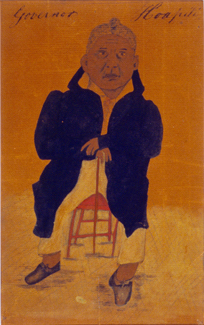
Ulumāheihei Hoapili was a member of the nobility during the formation of the Kingdom of Hawaii. He was a trusted military and political advisor to King Kamehameha I, known as "Kamehameha the Great". Although trusted with one of the last symbolic rites of the Hawaiian religion, he later became a supporter of Christian missionaries.

Hoʻolulu was a member of the nobility during the formation of the Kingdom of Hawaii. He was a trusted advisor to King Kamehameha I, also known as "Kamehameha the Great", and was one of the select few to know his secret resting place. His descendants continue the tradition of guarding royal burials. A major cultural site in Hilo, Hawaii is named after him.

Kahakuhaʻakoi Wahinepio was a Hawaiian chiefess and member of the royal family during the Kingdom of Hawaiʻi. Wahinepio means captive women in Hawaiian. Sometimes she is called Wahineopiʻo, or an extra ʻokina is added, calling her Kahakuhaʻakoʻi. She was also called Kamoʻonohu. She was considered Kamehameha I's third favorite wife and served as female Governor of Maui, an act unheard of at the time in the western world, but common in Hawaiian history.
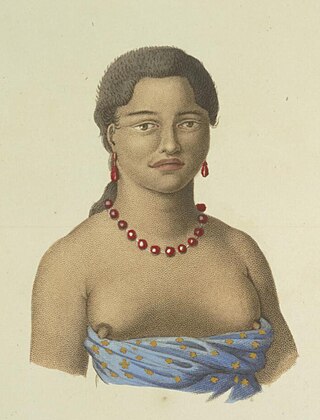
Likelike was a high chiefess and member of the royal family of the Kingdom of Hawaii. Before the standardization of the Hawaiian language, her name was sometime written as Rikériki. She was the favorite wife of Prime Minister Kalanimoku, a powerful chief and statesman during the early years of the Hawaiian monarchy, and she would accompany him on his interactions with visiting Western explorers and American missionaries to Hawaii. Likelike and her newborn son Lanihau died shortly after the baby’s birth due to the shock caused by cannons fired to celebrate the royal birth. Her funeral was conducted under traditional Hawaiian customs with the exception of a Christian sermon, which was the first performed on a Hawaiian royal.

David Kamehameha (1828–1835) was a member of the royal family of the Kingdom of Hawaii.

Peleuli, formally Peleuli-i-Kekela-o-kalani, was a Queen consort of the Kingdom of Hawaii as a wife of king Kamehameha I.

Julia Alapaʻi Kauwaʻa was a high chiefess of the Kingdom of Hawaii. Her name has been given as Julia Alapaʻi Kauwa and sometimes as Juliana instead.
Hewahewa was a Hawaiian religious leader who served as kahuna nui of King Kamehameha I and his successor Kamehameha II. Hewahewa was a powerful figure in the royal court of Hawaii and played a major role in the abolition of the kapu system, the decline of the native religion of Hawaii, and the introduction of Christianity to the Hawaiian Kingdom.
